Our research in to our club history continues, but as yet we do not definitively know when or where the club was formed.
We’ve found the existence of at least 5 ranges in and around Alton (none still used) and 3 clubs around the turn of the 19th Century but whether any of these formed the origins of the current club is yet to be proved.
Members certainly shot on at least 2 of the ranges and we have photos to prove it.
Pre-1894/5
A 600-yard outdoor rifle range located in the Wilsom area of Alton is shown on this map dated 1894/5.
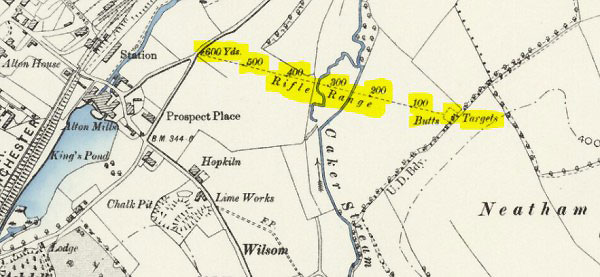
The 600-yard firing point is located on Mill Lane shooting over the Industrial Estate that now exists there in the direction of the high point of Neatham Down with the targets located where the Alton by-pass now runs to the Southern end of the sewerage works.
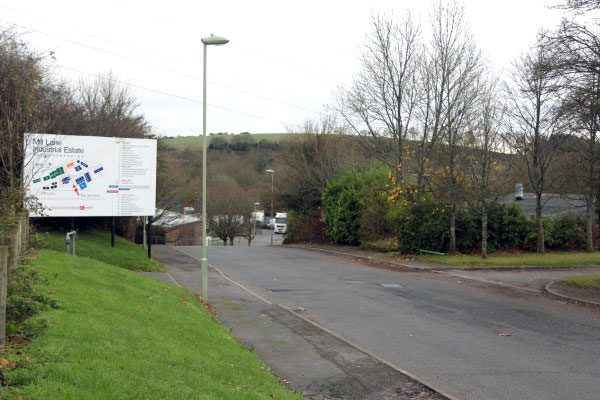
1899-1902
The dates of the second Boer War!
Due to the heavy losses suffered to enemy sniper fire arising in the early stages of the Boer War the call went out for British civilians to learn to shoot to defend their country should the need ever arise. “The Society of Working Mens Rifle Clubs’ was formed in 1901, with Lord Roberts of Kandahar as its first president.
At that time there were few rifle ranges in the UK and the costs of travelling and large calibre ammunition meant that few could afford to shoot on a regular basis. Smaller calibre .22 ‘minature’ rifles were far more readily available and the ammunition much cheaper. In 1903 the society amalgamated with the British Rifle League and the enlarged organisation was renamed “The Society of Minature Rifle Clubs’.
1906 – Wilsom Lime Kiln
The Alton Gazette of 2nd June 1906 reported that the “Mechanics Institute Rifle Club” was to open in Andrews Lime Kiln at Wilsom, where Charwell House Business centre is now located. Targets were erected and the President, H P Burrell, was to fire the first shot. The club was reported to have upwards of 60 members and F Arnold was its secretary.
This was one of those “miniature” rifle clubs shooting on a 100-yard range, which is shown on the 1909 revision of the earlier map.
If you visit the site now it goes back a long way into a chalk pit and one can see how suitable it must have been, as the current photos of the location try to illustrate – well, certainly in terms of a backstop. However, Tim Hobbis (a club stalwart), who shot there for 2 summers in 1955 and 1956 recalls there were just 2 firing points at 100 yards, located almost on the pavement to achieve the requisite distance. At the 50-yard point the “quarry” was wider and 4 or 5 positions were achievable. Tim also recalled a recess at the butts end to the left, which can also be seen on the map and that members waited round there whilst others shot! The site was owned by a chap who lived next door, and evidently he sought to increase the rent to a figure the club was not prepared to pay. So far as we are aware, 1956 was the last time that members shot there. We have yet to discover at what stage the site was developed for business.
Permission for the club to shoot here has now been located indicating a permission date of 2nd October 1952.
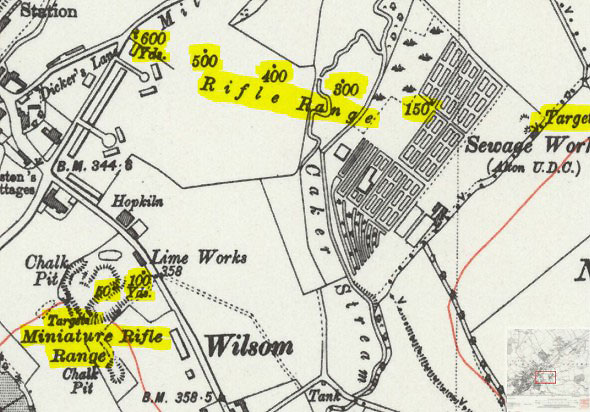
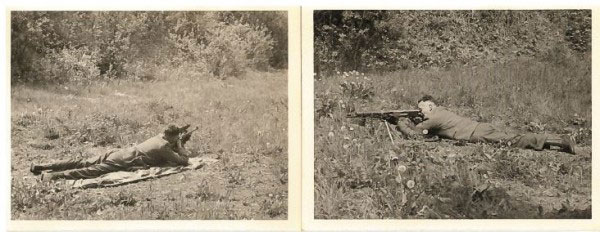
Jack Woodruffe actually shooting in the range circa 1955.
And here is the site now: -….
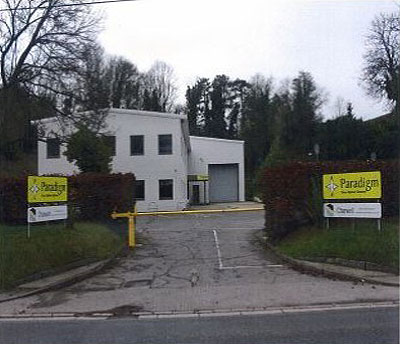
By way of a slight diversion, this Mechanics Institute was based in what is now known as the Curtis Museum as this caption and photo explains.
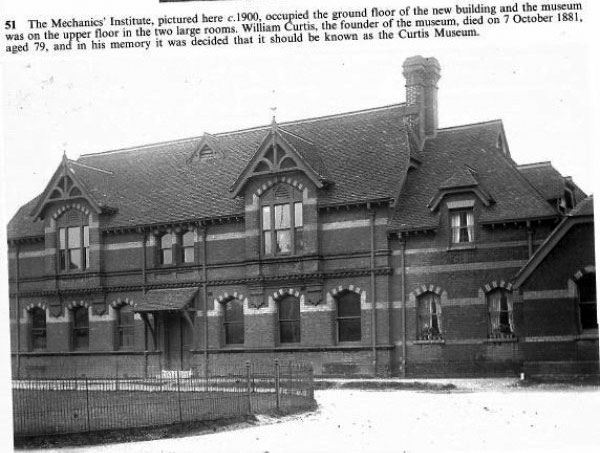
By 1908 this club appears to be referred to as the Alton Rifle Club as this article from the July 11th, 1908 edition of the Alton Gazette shows, reporting on a Handicap shoot that was shot at 25 yards, 50 yards and 100 yards.
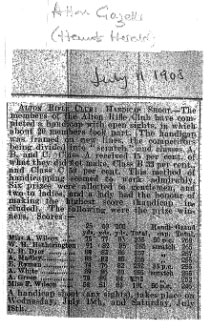
1896-’97
Stepping back in our chronology, 1896-’97 is another date that is relevant to our story. This was when the Volunteer Drill Hall at The Butts in Alton was built, which many years later would become the club’s home for quite a few years.
Farringdon Rifle Club(s) 1912 and 1929
Evidence has also been found of Farringdon Rifle Club or clubs – a quirky coincidence given the location of the range now. Whether these clubs have any connection to what is now Alton Rifle Club we do not know.
Nor do we know when the first one started or finished but we understand it was founded by Mr and Mrs Kennedy, the grandparents of the broadcaster Ludovic Kennedy.
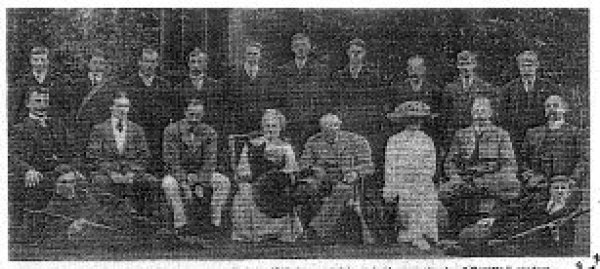
The above picture, which was taken in the grounds of Deanyers, the Kennedy’s house in Upper Farringdon in 1912. The tall chap (middle back) was the local bobby, PC Fred Davis and the lady in the large hat was Mrs Stopford. It is understood that many of the younger men in the photo went on to lose their lives in the First World War.
An article from the Alton Gazette of 1929 speaks of the Berry Hill Rifle Club, named after the hill on which the members would shoot, being land just to the North of Upper Farringdon towards Chawton and owned at the time by the Knights of Chawton.
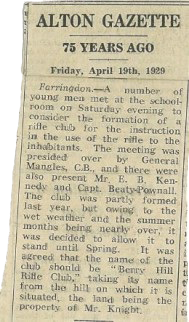
Crowley’s Brewery 1914
C W Hawkins book, “The History of Alton in Hampshire” published by Alton Urban District Council in 1973 talks on page 64 of the training of a Volunteer Corps following the start of the Great War who trained Drills weekly in the Cellars of Crowley’s Brewery, and where there was also a miniature rifle range. Crowley’s Brewery was located where Sainsbury’s now is. The article goes on to state that practice also took place in the outdoor range at Wilsom Lime kilns.
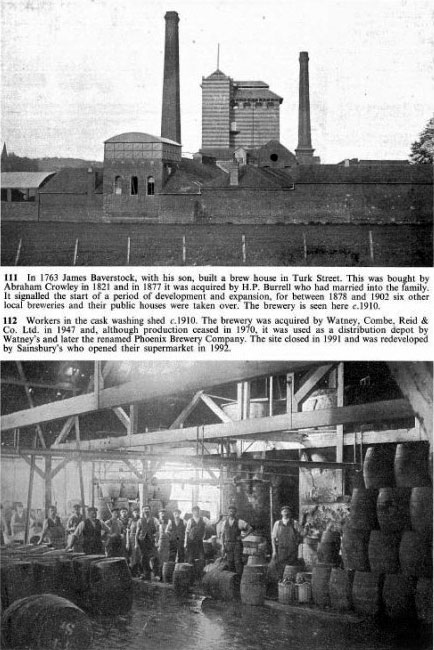
The 1930s
With dark clouds building in Europe, Britain’s War Ministry made Drill Halls up and down the country available to newly-formed civilian rifle clubs for a peppercorn (*) rent, with the obvious objective of having more young men capable of using firearms with knowledge and skill.
(*) Rents stayed at this peppercorn rate until the army, navy and air force were finally amalgamated into the current Ministry of Defence in 1964 https://en.wikipedia.org/wiki/Ministry_of_Defence_(United_Kingdom) whereupon rents became much more commercial.
Again, we don’t know exactly when the club did start to use this 25-yard indoor range but it might have been October 1936.
23rd October 1936
This is the date on the club’s certificate of membership of the Society of Miniature Rifle Clubs ….
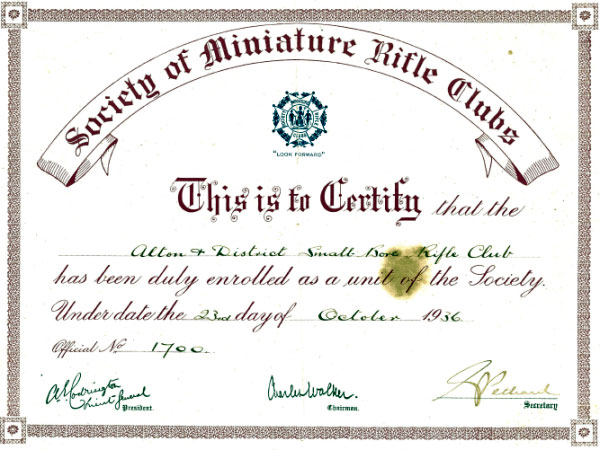
29th March 1945
This is the date on the club’s certificate of enrolment as a “unit” of the National Smallbore Rifle Association, with reference also made on the certificate to the Alton Home Guard Rifle Club which surely must have shot at the Drill Hall.
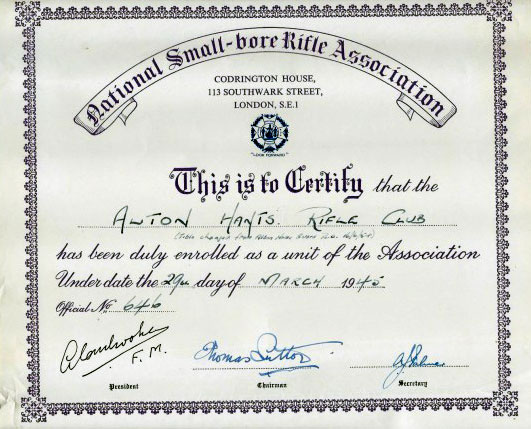
Alton Drill Hall
This was located at the town end of the Butts green on the corner of Albert Road, and we know the current club shot there for many years. The bottom picture was taken when it was being demolished but gives an insight into the interior.
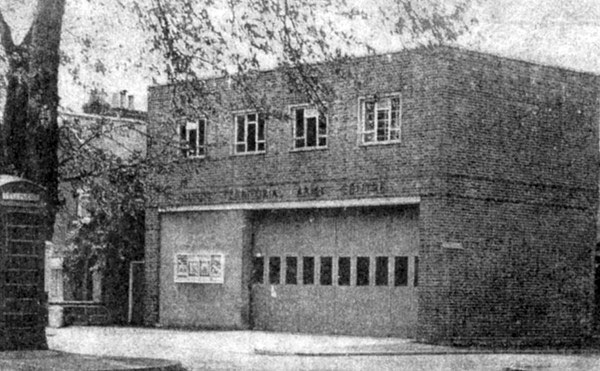
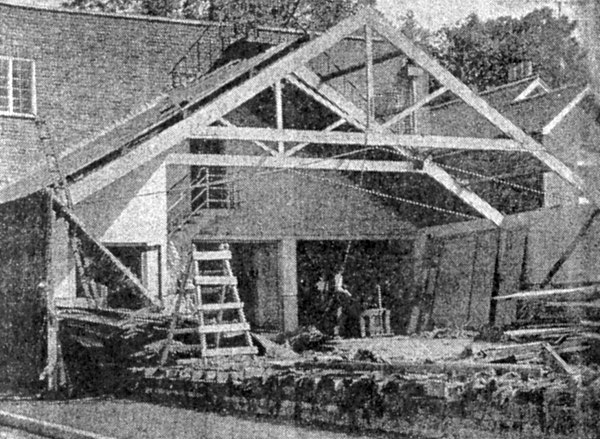
Shooting at the hall came with its own challenges, the hall was used for many different purposes and staging had to be brought out on each club night from which to lie on to shoot. Members also had their own light bulbs, this was an era in which the range was dark except for the butts where better bulbs were screwed in on shooting nights.
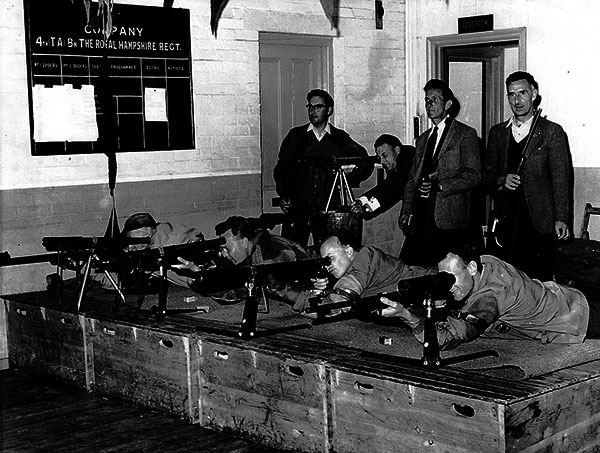
And here are several pictures of members in 1955 who shot in the drill hall
(Top Left): Comparing shot cards are Alan King, Tim Hobbis (in his own words, with hair!) and F Loveridge.
(Top Right): Comparing guns are Eddie Cass, Bill Oliver (with an Alton badge on his jacket) and Everard Armitage. The latter evidently was an exceptionally good shot and always invested in the latest and best guns, buying them in pairs! Here he is holding a Winchester 52c.
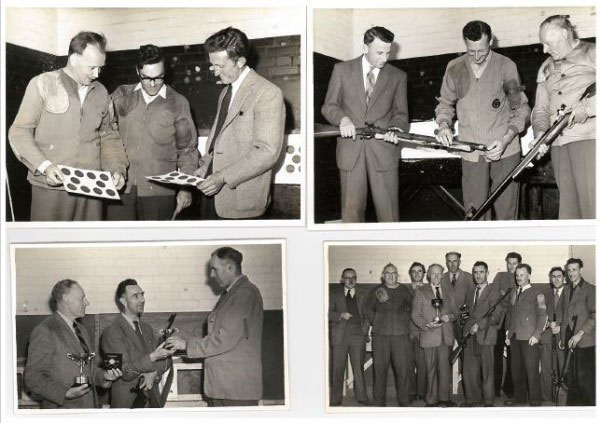
(Bottom Left): At an awards night are E. Armitage and Jack Woodruffe receiving prizes from long standing club member and Chairman at the time, Stan Denyer.
(Bottom Right): In the large group photo are, from left to right, Stan Milton (club secretary at the time), “Jacko”, TBA behind, Armitage, Denyer, Woodruffe, Ashton Kemp at the rear, Alan King, Tim Hobbis and Bill Oliver.
By the mid 1960s territorial army units up and down the country were reducing in numbers and eventually the Alton Drill Hall succumbed and was closed. It remained vacant for some years before eventually being demolished around 1972 we believe, and was replaced with the houses on the site now (see photo below).
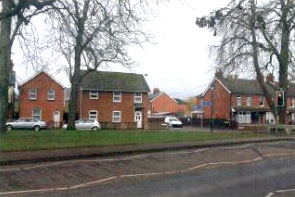
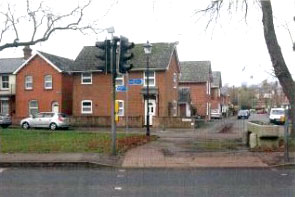
Tim Hobbis was acquainted with the Chairman of Aldershot Rifle Club, Wilf Green, and went and negotiated with him the hire of their range one night a week. This kept the club going, albeit with members having to drive up to Badshot Lea where the range was located each week.
At then end of the 1960s plans were announced to build a purpose-built sports centre in Alton and the club made representations for the inclusion of a range in it. The local archery club were interested too, and a “Projectiles Room” was incorporated in the design underneath the squash courts (where the gym is now located).
The sports centre opened in 1972 and membership quickly grew, prompting Donald Hartley and Keith Bacon to take formal coaching qualifications so new members could be properly trained. At its peak the club had about 50 members.
Towards the end of the 1970s what many members at the time felt to be a conspiracy took place. Many sports operated at the centre were run by its own management team and staff, and were available to participate in at a wide range of times. It seemed that autonomous clubs simply hiring the facilities were not wanted. By this time the Projectiles Room was used by a children’s nursery in the daytime and measurements of lead levels were taken and proved high. This came at a point after the designed extractor fans had been removed from the building for reasons unknown but, to cut a long story short, shooting in the room was prohibited.
As a consequence, the club approached Aldershot once more with a view to hiring their range again. Aldershot were obliging, however, the only free night was Saturday night!
Brightstone Lane, Lower Farringdon
This Saturday evening slot at Aldershot’s range was understandably not popular with members who started to talk seriously about building their own range.
Donald Hartley, a long-standing member of the club was a farmer and identified a small parcel of land on his farm that might be suitable. It was wooded and would need some levelling, but it backed naturally into a hillside which would please potential range inspectors.
A local architect, Raymond Figgins was commissioned to prepare some drawings to support a planning application and this was duly submitted to East Hants District Council on the 11th August 1980.
It envisaged a range built out of precast concrete panels, used in prefabricated buildings, and with an asbestos (yes…) roof.
The Geales Crescent “Prefabs”
As discussions of the club building its own range developed, a core working party comprising Donald Hartley, Bill Oliver and Keith Bacon started to make enquiries from suppliers of dismantled prefabricated buildings. The prices were quite high – about £1,000 plus VAT – however fate was about to play into the clubs’ hands….
About this time (the Autumn of 1984) they became aware of a proposal by East Hampshire District Council to redevelop Geales Crescent in Alton (near Anstey Park) which at that time comprised approximately 30 prefabricated bungalows. A bid was duly put in to buy 3 of the units. Successful bidders for the units were notified on 31st December 1984 and the clubs offer of £450 + VAT per unit proved successful. Payment was made on 12th January 1985 for numbers 36, 42 and 44.
The purchase was actually made by Donald Hartley’s farming business, the range was to be built on his land and he had ascertained from HM Customs and Excise that the VAT incurred on buying the units could be reclaimed by the business as the range would qualify as a zero-rated new building – one suspects he didn’t actually tell them the purpose to which this new “farm building” was actually going to be put….
A key condition of the sale of the prefabs was that they had to be dismantled by the buyer and the sites left clear by the end of April 1985. Weekend working parties were quickly organised and careful demolition commenced – it was soon realised that the metal roofing sheets, the roof joists and many other elements of the buildings could also be recycled into the new range.
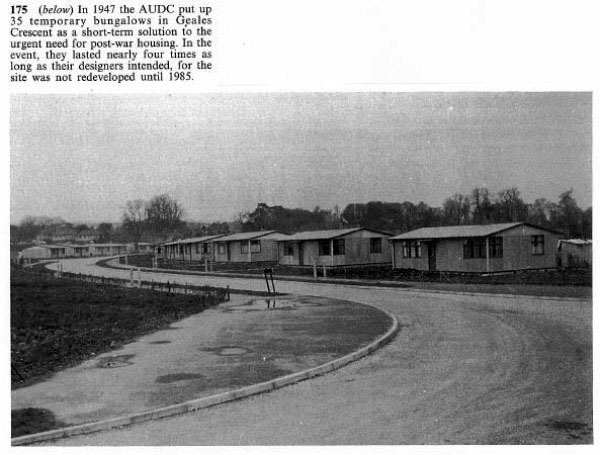
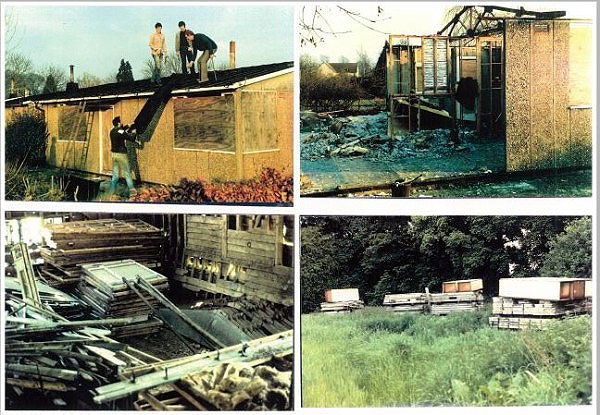
It also became apparent that 3 units were not going to be enough and number 38 was also bought in early February.
Everything was transported back to Donald’s farm in Lower Farringdon by tractor and trailer, a slow process given old-fashioned tractors of that era could only do 20mph!
The parcel of land to be used backed naturally into a hillside and, because it was wooded, was unused for agriculture. Being a farmer, he had access to a wide range of suitable machinery and in conjunction with the local “JCB Man”, Danny Cameron, the site was cleared over the winter of 1985/6.
The project was expected to cost about £10,000 in total, almost all spent on the prefabs and building materials, with the members putting in all the labour.

Members then set to, firstly digging the footings; Donald operated a mini-digger rented from Vincent Hire in Four Marks and then mixing and laying the footings by hand. The work was lot harder than getting in a load or two of ready mix, but far more affordable and this approach also allowed them to lay sections at a time. Reinforced Steel Joists (RSJs) were inserted vertically at periodic intervals and the wall sections had to be built along to them before this could be done. Again, the combination of some decent machinery including a large tractor-mounted mixer and many hands made light work. Amongst those in the pictures are Donald Hartley, Peter Gibbs (in shorts and wellies) and Keith Bacon (pouring water into the tractor mixer).
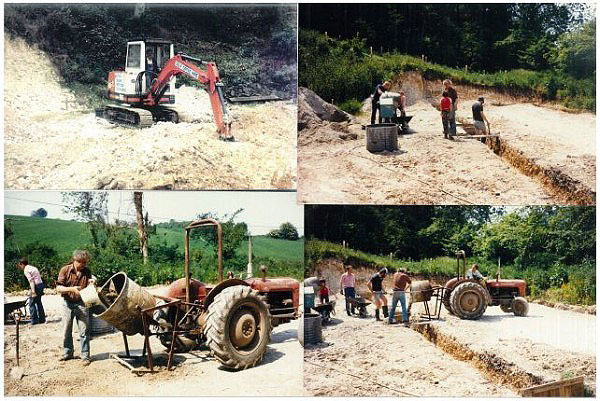
With the footings in place work began building the walls, bolting the concrete sections back together to form a long rectangular building. That’s Bill Oliver, a club stalwart who played a leading role in the build, standing in the bushes supporting a section from outside whilst it is trued up.
The two side walls were built in parallel and the modified and strengthened roof joists were then lifted into place using a tractor-mounted forklift which then started to tie the building together.
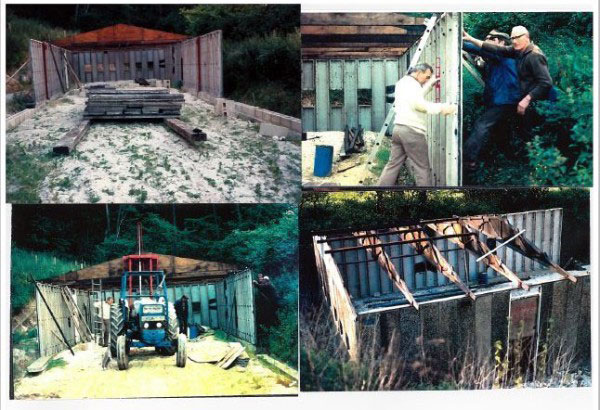
This in turn was followed by refitting the steel roof sections.
There was just a small gang of members doing all this building work in their spare time. Each roof truss was purpose-made out of the Geales Crescent ones to fit the new span and that all took time.
Eventually the range approached the point where the club house was proposed to join it, and here a block work partition wall was constructed.
The date on the rear of one of these photos suggests it was the Summer of 1988 by this stage.
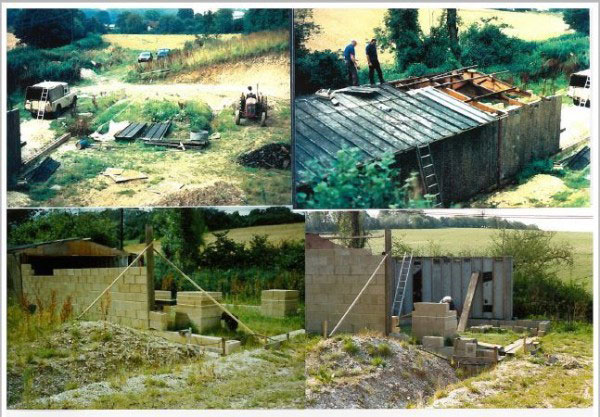
Eventually the end was reached, and the roof finished off.
A concrete slab was laid where the club room would be subsequently be built, and spare building materials to be used in its construction were stacked there for a while.
At this stage there was no mains electricity supply to the range. Power was supplied, as it had been throughout the build, by a large generator brought up to the range by Donald in the back of his Land Rover, and it was plugged in to a socket at the Butts end of the range. Mains electricity was brought in during the Summer of 1995 at a cost of just under £5,000.

We’ve not (as yet…) located any photos of the internal fit-out of the range. Construction of the Butts was an involved and complicated fabrication exercise, firstly of the steel bullet deflectors, then the anti-splash curtain and finally the false wall onto which the targets are hung. The range was designed from the outset for both prone rifle and standing pistol shooting so the steel butts have 2 levels of deflectors. The interior was also timber-clad and lighting installed.
We understand the range was granted its certificate in the summer of 1991 with Donald Hartley pictured above firing the first ever shot on the evening of 23rd July 1991.
To be continued….
